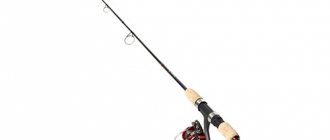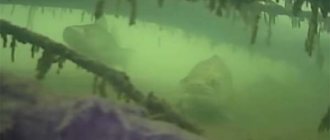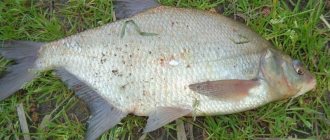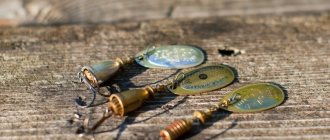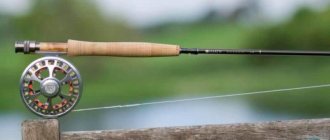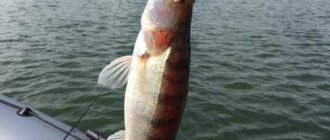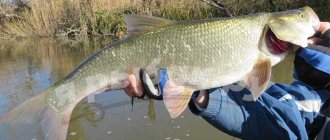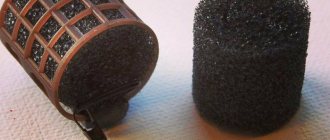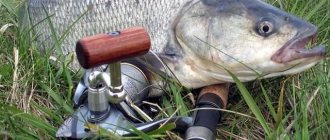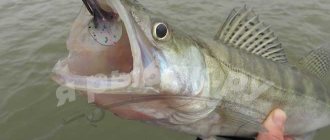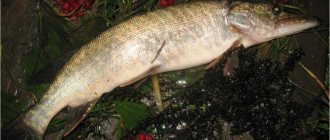The article talks about catching predatory fish with a spinning rod in snags, how best to fish such a promising area, what baits and baits to use.
All experienced spinning anglers know the fact that various kinds of predatory fish like to settle in thick snags, but fishing such promising areas is quite problematic - they are tormented by dead hooks.
From a boat or shore
Fishermen often argue: what is the best way to process such places, from the shore or from a boat? Boatmen assure that only from the water can you choose the right sector of “firing” and work clean patches of the bottom without snags, and when fishing it is somewhat easier - large fish can be quickly pulled away from the snags to a clean water area, where it’s easy to wear them down and take the prey. But coastal spinners do not agree and claim that only when fishing from the shore or by climbing trees that have fallen into the water, you can accurately catch thick snags, because the rod is fixed on each cast with an accuracy of a centimeter, while the boat on the river is tossed by the current. In addition, the predator often stands closer to the shore, and such points from the river simply cannot be penetrated properly due to the continuous underwater “wooden fence”. I have repeatedly been convinced of this from my own experience; my first fishing in snags was especially noteworthy.
Winter fishing in snags
Photo: Anatoly Mailkov.
The ice shell that covers reservoirs at the beginning of winter can be either flaky, like a pie, or matte and poorly permeable to light, or transparent, like glass until snowfalls begin.
The last situation is the most difficult for fishing, because in this case too much light enters under the ice through very clear winter water, in addition, the fish are greatly frightened by all the movements of anglers on the ice surface, especially if the depth is shallow.
Here it naturally suggests itself to go fishing at medium and deep depths, where the illumination is not so great and where the fish practically does not notice what is happening above, and therefore bites more boldly.
However, at the beginning of freeze-up, ice above significant depths is not always safe, since the water above them cools down and freezes several days later.
Another quite successful way of fishing from thin transparent ice at shallow depths can be fishing in dense snags, which abound in many large and small reservoirs, especially in their upper reaches or at the mouths of tributaries.
And, by the way, at the beginning of winter, various fish clearly gravitate towards the remnants of forests and dense bushes flooded with water and leave these places by mid-winter, when the content of oxygen dissolved in the water here is likely to significantly decrease due to rotting wood and algae residues.
In the very first weeks of freeze-up, perch, roach, pike, and even crucian carp clearly find ambushes, shelter from light, and various food in the form of small animals among the trunks and branches of bushes protruding and lying on the bottom.
It must be said that fishing in snags is not as easy as it might seem at first glance. First of all, due to the specifics of the fish’s diet here, not every bait here can produce bites - it is important to guess with an imitation that, in its movements and even appearance, will be as similar as possible to the behavior of the main food of the local fish. And the bait can be either a spinner or a jig.
In the first case, it is advisable to give preference to those spinners that deviate slightly to the sides during play in order to avoid a large number of snags. Such baits include narrow spinners, weighted at the bottom, like the “Gvozdik” spinner, in which the hook is rigidly soldered and not suspended by a ring.
It is necessary to play such lures in snags with a small amplitude in order to minimize the movement of the bait to the sides at each lure cycle. This is also facilitated by the use of thicker fishing line, which will have little effect on the fishing results, contrary to popular belief.
At the beginning of fishing, you only need to stretch the working section of the fishing line with force in order to remove its “ringing” after leaving the reel drum. Also, in case of false “bites” of snags and sharp hooks, a strong fishing line will allow you to avoid annoying losses of bait.
Of course, fishing will be very difficult with frequent hooks and constant fiddling with the unhooking, if, when catching one or another predator among snags, you rely on balancers that make wide movements under water along a complex trajectory. However, this applies more to the “striped” one, which loves to get into the very thick of underwater dead wood.
Read the material “Invisible roe deer: simply impossible to imagine”
But in the case of pike, the fishing tactics with a balance beam are structured somewhat differently - this predator often stands along a narrow edge on the border of a snag, which usually means a drop from shallow water into the bed of a flooded stream, ravine or river. Here the likelihood of snags is sharply reduced.
By the way, if you look closely at the surface of the ice with tree stumps protruding from it, you will notice that the snags do not stick out so randomly - a certain “structure” can be traced, outlining the boundaries of an invisible underwater ditch. It is near this border, on both sides of it, that holes need to be made, since here, in the zone of depth difference, the highest concentration of both white fish and predators, large ones at that, is most likely.
| Photo: Anatoly Mailkov. |
And when fishing with a jig, it is better to use stronger tackle so that a fish that has bitten can immediately be dragged straight ahead, otherwise it will lead the line behind the nearest branch. Of course, you should not fish in snags with various tandems of baits and, of course, you need to have a reliable hook on hand.
And also, among the snags sticking out of the ice, it is important to choose the right position - it happens that you make several holes around a stump until the bite starts in one of them, but the distance between the holes is only 40-50 centimeters or less.
Sometimes it happens that the depth in all holes is approximately the same, but in one of the holes the bait seems to “fall through”. And only in this “special” hole, which must be found by “detailed” drilling, is an excellent bite observed.
Read the material “Perch from under the ice itself”
Also, in snag fishing, the standard jig game, which is acceptable in clear water, rarely produces results. Apparently, among the snags, small live fish food constantly makes slow vertical movements, so the frequency of “shaking” the jig is not so important as its speed of movement up or down. So sometimes simply excellent results when catching large fish are achieved by a very slow and even “pulling” of the bait from bottom to top; many bites also occur while lowering.
For this technique of playing at relatively shallow depths, which, by the way, is not hampered by a rather thick fishing line, small models of jigs such as “droplet”, “ovsinka”, “uralka”, “nymph” are most suitable - both with bait and with multi-colored artificial refills like beads, cambrics, chains, metal balls.
It is desirable that the baits be painted black, brown or green, but sometimes copper or brass colored jigs are out of competition.
Of course, multi-hook imitations called “devil” and “goat” work great among snags, but with them it is difficult to avoid a large number of hooks, and when the fish, which has already sat on the bait, throws to the side.
FOR LIVE TACKLE
If we talk about perch, then it is most effective to catch it with fry, using a simple winter fishing rod with a nod, a sinker weighing up to three grams and a hook on which the fish is attached by the lip.
It is better to lower the rig slowly, observing the nod, doing this first from a standing position - a striped predator can detect itself and peck on any horizon, even under ice.
Read the material “Catching correctly without bait and in the grass”
And pike more often have to be caught with a tackle similar to a set-up, when the line on the reel of a regular rig is fixed and does not come off after the fish grabs. This way there are many empty bites, but almost all the pike along with the equipment does not remain in the snags.
To further reduce losses, pike baits should be placed not in the thick of snags, but along its border; it is advisable to raise live bait from the bottom a meter or two so that it cannot find shelter.
Anatoly Mailkov January 15, 2021 at 11:40
My first snag fishing
I carefully reached the rubble, stood on the point, ripper, 30 g head. I tore off one bait, one had a good bite, but failed to realize it. If the head had been a little heavier, at 34-35 g, it could have been better, because the current in this place was very strong, the bottom of less than 30 g does not break through at all. Everything is covered in snags; if you can’t use a step, you’ll get caught in an instant. Therefore, I got used to fishing with a spinning rod by dragging, throwing the bait at an angle to the stream; when I feel a slight delay, I make a couple of turns with the reel to pull it off the snag. Only when the ripper reached a clean bottom did the classic step begin. However, even close to the snags, there were no bites at all - only in them themselves, where the fish had clearly huddled, intimidated by the numerous motor boats. When I figured out the location of the wooden underwater labyrinths, the bites went to the 7 cm golden rubber with sparkles, the hook remained open. Fishing is quite nervous, a small mistake and goodbye to the bait.
Pike fishing in snags
Finding snags on an unfamiliar body of water can be difficult . To do this, you can explore the water area on a boat with an echo sounder . But in some cases, snags protrude directly above the surface of the water.
This often happens on reservoirs , when the remains of flooded trees are clearly visible, and in such a situation there is no need to explore the reservoir in search of a promising point.
If you are going to fish in snags, you need to choose the right gear . To prevent the pike from tangling the equipment after biting, it must be quickly moved away from the bottom debris. This will require a powerful rod and thick fishing line. A strong spinning rod is one of the most important conditions for successful fishing among snags. When using braided fishing line with a high breaking load, you can tear the bait out of the hooks, and in this case the losses will be minimal .
No breaks in the snag
Subsequently, I began to catch pike in the thick of the snags, with virtually no breaks in the bait. The secret is simple - a homemade Texas rig helps out, it is completely unhooked, even if you drive it from snag to snag. I’ve been testing it on the river for several seasons now – it works just great! Now I began to feel more relaxed, having become a sort of “master of writhing”, I fish in strong places as calmly as on some straight run with a clean sandy bottom.
The equipment is simple
A bullet-shaped lead sinker runs along the braid - with the pointed part towards the rod. Plus a regular twister on an offset hook, I tie it directly to the braided line, I don’t use a leash, I don’t like it. The bullet-shaped load simply “licks” the snags and does not get stuck in them. I tried to place weights of a different shape - they instantly got stuck between the branches, even spherical ones. The “bullets” are homemade, I couldn’t find the required shape on sale, but casting them yourself is not a problem. You can do it quite simply: take a large olive (20 grams) with a sliding hole, cut it in half - as a result we have two weights of 10 g each. The holes on the side of the wide edge can be flared so that the hook ring fits into this recess. Another important nuance: if you fish with braid, it is advisable to polish the hole in the weight well, for example, with a suitable steel knitting needle, so that there are no burrs on the lead that spoil the braided line. This problem is completely eliminated by a suitable plastic cambric glued into the hole. Although, if it is perfectly smooth, then it’s fine without cambric, lead is a soft metal. I bring the offset tool’s tip outside the body of the twister, then submerge it a little in silicone so that when it comes into contact with the writhing, it does not spontaneously release and stick into the writhe. This rig also has a minus (like any rig with an offset hook): if there was a fish’s grip, but it didn’t catch, then you need to quickly reel in the rig, because the hook is freed, and there’s still a lot of darkness ahead, and if you continue retrieving, then the very first writhing is the end of the bait.
Tests
At first I tested such baits on the river, using a light spinning rod, while hunting for perch in thick snags, where people usually only dare to fish on the bait, and I didn’t lose a single bait. The perches we got were great, and on the first fishing trip we caught some good fish, although there were also quite a few idle bites. But the realized percentage of pike bites is large - when the toothy one is actively fattening, often each bite brings a fish. When the bites are cautious, it’s not so easy to hook. With such non-hooking equipment, there are quite a lot of wiring options. You can simply jig, or slowly drag it along the bottom soil through flooded trunks. I often take pike using a broach. Everything is done like this. Cast, the bait falls to the bottom, followed by a pull-up of half a meter, a pause, another pull-up, the whip rests on the log, pulls the sinker over it, it falls to the bottom, then the twister slowly glides, loaded only with a hook, as it falls and the current plays along with the bait, often in such a moment and a great bite follows. There is a pike!
Problems when playing
When fishing through trunks, there are also no problems - the load does not catch, the hook is in the pike’s mouth. With such broaches, you can very clearly hear all the wiring through the braid and weight, despite the fact that it is sliding. And you quickly figure out how the rubble is located at the bottom. The fact is that on the rivers everything changes radically every season, the changes are especially noticeable after the spring flood - something is washed away, new holes appear somewhere, and the snags themselves change their location - in some places old trees are carried away by the current, in others then, on the contrary, new ones appear. It turns out that you come to a new unknown area, but you quickly figure out what’s what in this promising place. Although a new snag is not a panacea - the next day there may be no fish here, only a lot of careful pokes - either perch or pike perch are playing around. But as soon as you work the clean bottom next to the snag, the pike sits almost immediately. Therefore, if the snag itself does not bring bites, it is always useful to check the places next to it, the adjacent clean run with the coastal edge is especially promising - the bites of a respectable pike very often happen there. Last spring, in May, we managed to catch a pike weighing 7.5 kg at such a point. The grab took place on the yellow “predator” - the redhead. The “mother” took it thoroughly, a sharp blow on the pause, when the bait had already gone to the bottom, the braid was thrown up, and immediately hooked sharply.
Next season I will be more persistent in trying my homemade “Texas” in thick grass, because I have already become convinced that among water lilies the equipment works great, without clinging to strong roots, near which large pike like to stand, especially in hot weather. At the same time, I do not at all presume to deny the effectiveness of branded Texas equipment - with brass weights, beads, but where can you buy them, quality ones? Moreover, I am almost sure that silicone worms, mainly designed for such fishing in strong places, will give better results than a regular twister, because the “worm” works great even with the slowest and shortest pull. I have experience in fishing with such decoys; I made them myself in the microwave, where the silicone melts well without any unpleasant odors. An ordinary long cylinder was cast, the end was slightly flattened with an iron through the foil, obtaining a very movable tail. I just haven’t figured out how best to equip the “worm” with a hook, because the body of this bait is quite long. I tried to put it on an offset bait with the longest shank that I found, but the hook tip still came out close to the head, and often pikes tore off the tail and rear part of the bait with impunity. We need to try other options.
Catching roach on the lake
The realities of modern float fishing
Catching crucian carp with a float rod for bread
Fishes living in snags
Not only perches and roaches live in snags, as is commonly believed. It all depends on the body of water. I had a chance to catch bream, chub, silver bream, rudd, minnows, and ruffs near fallen or flooded trees. Pike are permanent inhabitants of areas littered with wood.
Moreover, there are often days when the jig is constantly attacked by small spotted predators, often biting off the bait.
And even after releasing the runts into the wild, there is no guarantee that they will not be caught again. This happened more than once. But small pikes do not grab the balancer, which means that their main food, apparently, is invertebrates.
I noticed that in rivers and river channels, at a specific point near a tree resting in the water on a certain day, fish of one specific species are most often concentrated. And on another day, you can stumble upon other inhabitants of the depths, which adds variety to fishing, making it more interesting. It is extremely rare to catch different fish at such points. All the same, fish of some species dominate the catch. However, this does not apply to lakes and ponds. In them, near the same trunk, day after day, mostly fish of the same species will bite. In rare cases, the by-catch of, say, perch will be several small roach.
With good bait placement skills, bites in snags are pronounced. The fish bite quite greedily, as if trying to get ahead of each other in the fight for the right to have prey. Sometimes, as soon as the bait goes under the water, a bite immediately follows. However, negative changes in nature can worsen the bite. But the absence of bites is not a sign of a lack of fish. They do not leave their shelter, but simply do not show their presence.
Read! How to choose a catchable balancer
In such a situation, you can only rely on yourself and experiment with baits and wiring techniques.
How to feed and catch in a snag
As a rule, the snag is the most fishy place in the reservoir. Both carp and predators love it. There are places for shelter and ambush, a lot of larvae and insects. In snags they catch carp, crucian carp, tench, roach...
Fishing right in the snags?
But it is difficult to catch fish in snags. If you manage to avoid getting caught when casting and retrieving the bait, then after hooking even small fish manage to get tangled in the rig by the branches. Everything is determined by the specific location of the branches at the bottom.
It happens that a safe window is found right among the windfall, into which you can lower the equipment and pull out small and even medium-sized fish using high-strength tackle. But this is problematic to do with large fish. It is difficult to hold the carp in place when it makes the first jerk, developing a force of up to 4 times its mass. And it’s practically impossible if the distance to the equipment is more than 10 meters - the fish will move to the side too quickly. Therefore, fishing directly in snags, in most cases, does not ultimately bode well for the angler. You need to fish effectively near such places. But how to lure the fish to a clean place?
Where to fish, what is the distance to snags
The solution is to fish near snags, or in large gaps between the branches. Place the equipment at such a distance from the snags that the hooked fish cannot escape to a strong place. But if we are talking about catching medium-sized carp, then the distance should be at least 3 meters, and preferably 5 meters, provided that durable gear is used that can keep the carp on short notice. In addition, fishing is difficult in that the fisherman needs to remain constantly at the rods in order to prevent the escape of prey into the windfall with his actions. True, the intensity of fishing in such places often does not suggest anything else.
A flock of medium-sized carp, being the strongest in the reservoir, often takes a liking to snags.
How to lure fish
To successfully fish near snags, you need to lure the fish out of the snags using bait. The distance to the bait spot should be kept as minimal as possible, because it is not a fact that carp or other fish will be tempted by the food and travel far from their windfall home. But what this distance should be to the first hook will have to be clarified with practice. Below are general recommendations on this issue.
Most of the preliminary feeding is thrown to the fishing point 4 - 5 meters from the snags. Then a feeding path is made to the snags. Moreover, it is better to throw food in bulk, rather than in balls. Its quantity should gradually decrease, at the 1-2nd meter 4 handfuls of bait are scattered, at the 3rd meter - 2, at the 4th meter - 1 handful. A little bait is thrown onto the edge of the snagged area. For carp, it is necessary to use only nutritious food, for example, a home-made composition - a mixture of corn with barley, with the addition of chopped worms. Effectively flavored with proprietary flavoring.
Feed in advance
Feeding snagfish immediately before fishing is not as effective as feeding it in advance, for example, in the evening so that you can catch it in the morning. Fish need time to find food and settle into a new place. Such bait should be placed in balls of soil so that the release of grain and worms is gradual. In fact, a small bait is set up in ground balls.
This type of fishing for large fish near snags involves the use of a durable carp rod 4–5 meters long, together with an inertial reel. Usually the leash is from 0.16mm, and the main line is from 0.2mm. The weight of the equipment is 3 – 4 grams. Only powerful tackle will work as expected next to the snag and keep the carp short...
Fishing in snags on the river
The river is always replete with snags; they move in the water. The fisherman needs to choose the fishing point carefully, at some distance from the snags. Baiting in snags here is done in dense balls that could resist erosion for some time. Or fishing is carried out with heavy feeder tackle. There are many more features regarding the installation of gear, its location on the shore... The casting is carried out downstream of the snags, and there will be fish there too. The carp will quickly hide in the snags, moving against the current. The task is to hold it, fortunately for the river the fish are not so careful, there are practically no restrictions on diameters and sizes...
